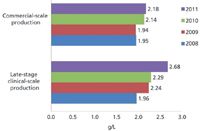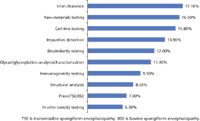Biosimilars' Technology Needs
Biosimilar manufacturers need better expression systems and analytical tools to compete.
Biosimilars manufacturers recognize that to compete and provide cost-savings relative to reference products, they must be cost-effective. Some improvements for biosimilar manufacturers will include: improved expression systems, higher titers to reduce capacity requirements, and better assay methods to permit process monitoring, and product characterization (1).

Eric Langer
Technology needs
Improved expression systems. Biosimilars manufacturers will need to increase expression-system yields to enable use of smaller bioreactors and lower cost facilities. New expression-system technologies, along with large single-use bioreactors for late-stage and commercial manufacturing, may begin to displace stainless steel for commercial manufacture. This shift is particularly true for recombinant monoclonal antibodies (mAbs), where a large number of biosimilar products are in development. mAbs have high repeated dosing requirements, and large amounts of protein in the magnitude of hundreds of kilograms per year often are needed.
New platforms (i.e., new host cells/organisms) and genetic-engineering advances applied to traditional platforms also can offer advantages in product yield, product quality, lower operating, purification, and infrastructure costs (2). Some newer technologies offer shorter times required to go from gene to transformed host cell line/organism to commercial-scale manufacture. Currently, there are just a few major players promoting new expression-system technologies, but there are a many advances ready for adoption, adaptation, and further development.
Higher titers to reduce capacity requirements.The trend in increasing protein expression yields has had broad ramifications for biosimilars. From lowering construction requirements to increasing bottlenecks at the downstream end of production, the effects of upstream advances and the availability of more varied expression systems have created options and problems not previously seen. According to a recent BioPlan Associates analysis, the overall average yield reported for commercial mAB manufacture in 2011 is 2.18 g/L, up from 1.94 g/L in 2009 (see Figure 1). (1). It was not that long ago that mammalian-cell culture commercial production yields were lucky to achieve 1 g/L or greater (1).

Figure 1: Annual change in titre, commercial, and clinical-scale production of monoclonal antibodies, 2008â2011 (1). (ALL FIGURES ARE COURTESY OF THE AUTHOR)
The next generation of commercial products will have an even greater average yield. For late-stage clinical manufacture, the overall average in 2011 is 2.68 g/L, up from 1.96 g/L in 2008. Although protein yields over 30 g/L are being reported by expression system developers and early adopters, these yields are the exception, and yields for commercial manufacture in the 5–10g/L range are more likely in coming years (1).
Analytical technology. Better assay methods to permit process monitoring and product characterization will enable more biosimilar approvals. FDA and other regulatory agencies will largely rely on analytical data to support conclusions that biosimilar candidates are sufficiently similar to their marketed reference products to allow generic-like approvals. As such, regulators are likely to look for better analytic characterization through more combinations of attributes at greater sensitivities with multiple complementary methods. For drug developers, analytical method development and testing will be less expensive and quicker compared to reliance on clinical trials to support approvals.

Figure 2: Select new product-development areas of interest (1).
Progress in the development of bioprocessing-related assays and analytical equipment, however, has not kept up with industry demands. Better analytical technologies are being sought by the industry for improving productivity, process monitoring, real-time product quality control, process optimization, and analytical characterization for biosimilars. These trends are reflected in a recent BioPlan Associates survey, where more than 32% of biopharmaceutical manufactures and 21% of CMOs expressed demands for improved analytical assays (see Figure 2). The survey showed that, after single-use/disposable bioprocessing equipment, more relevant and cost-effective assays and analytical equipment is a strong need. Areas of interest include better probes and sensors, in-house real-time analyses of process streams, use of biological assays to determine active agent-related quality (e.g., glycosylation variants) and outsourcing of specialized chemical analysis and biological assays.

Figure 3: Percentage of all biopharmaceutical Industry vendors actively funding assay-related R&D (1).
More than one quarter (26.2%) of respondents cited analytical testing and drug-product releases as major factors likely to constrain their organization's production capacity during the next five years. Respondents identified 26 areas where new and improved testing technologies are required. More than 40%, cited glycosylation and comparability testing (primarily for demonstration of comparability between lots/batches of the "same" product, but also to show similarity for biosimilar products). Also, early 40% of all respondents cited the need for better host-cell protein assays, biophysical characterization during process development, and in-process testing and aggregation assays. Figure 3 shows the percentage of vendors funding assay-related R&D.
Eric Langer is president of BioPlan Associates, tel. 301.921.5979, elanger@bioplanassociates.com, and a periodic contributor to Outsourcing Outlook.
References
1. BioPlan Associates, "8th Annual Report and Survey of Biopharmaceutical Manufacturing Capacity and Production: Survey of Biotherapeutic Developers and Contract Manufacturing Organizations" (Rockville, MD, April 2011).
2. BioPlan Associates, "Biopharmaceutical Expression Systems and Genetic Engineering Technology: Current and Future Manufacturing Platforms" (Rockville, MD, 2008).

Pharmaceutical Tariffs Are Imminent: How Industry is Bracing for Impact
April 16th 2025On April 14, 2025, the Trump Administration launched a national security-driven investigation into pharmaceuticals, a move that will likely result in tariffs being placed on pharmaceutical drugs, ingredients, and other components that are imported from outside of the United States.
Drug Solutions Podcast: A Closer Look at mRNA in Oncology and Vaccines
April 30th 2024In this episode fo the Drug Solutions Podcast, etherna’s vice-president of Technology and Innovation, Stefaan De Koker, discusses the merits and challenges of using mRNA as the foundation for therapeutics in oncology as well as for vaccines.